I think we have reached ‘peak pithivier.’ Everywhere I turn, I am running into the things. Menus, TV, recipe books and blog posts are full of the things. And how posh they sound, right? In actual fact, there is a good reason that pithiviers are ascendant – they are just as tasty as a pie, but an awful lot easier to make. A bit of time with egg and a carving tool, and they look stunning. They are a fantastic crowd pleaser, and very easy for busy restaurants to make in advance, chill, and cook to order because they do not occupy an army of pie moulds. They are made even easier because of the availability of ready-made puff pastry. Nobody in their right mind has the time to make puff pastry from scratch, so buying a roll of it, cutting it into circles and plopping a filling on is simplicity itself.
Pithiviers date back to 17th Century France in the commune of Pithiviers in Orléans. The dish was originally filled with sweet things like frangipane. A pithivier filled with frangipane is exactly the same thing as the galette des rois (or ‘Twelfth Night cake’) that the French cook to celebrate Epiphany. It was later that savoury fillings became the thing, and it seems to be that these days ‘pithivier’ is used to denote savoury pies, and ‘galette’ seems to dominate when we mean a dessert.
Game lends itself very well to pithiviers if care is taken in the selection of the meats. Pithiviers are not filled with a load of thick gravy to create moisture, so the way to deal with that for often-dry game is to: 1. Ensure a good mix of game varieties,; and 2. To pour some appropriate sauce into the top of the pie when it is done.
In order to get the traditional spiral carving right, some rules need to be followed. Once the pithiviers are assembled and the edges crimped with the tines of a fork, chill them for 10 mins. Then brush them with egg, and chill them for another 10 mins. Once the egg wash is solidified on the outside of the chilled pie, the spirals can be carved with the point of a small knife. The pithiviers are then ready to cook.
The recipe given here comes from Raymond Blanc. The dish was shown in a recorded segment on BBC’s Saturday Kitchen in November 2018. The very next week, Helena Puolakka came on to cook a dish from her restaurant. It was another game pithivier, thereby proving my point regarding ‘peak pithivier.’ You might as well just get with the programme and make your own.
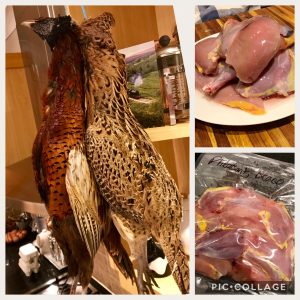
There are some notes on pheasant preparation that can affect the way you make this dish. If you go to a butcher for your pheasant, then you can get a whole, plucked bird and follow the Blanc recipe exactly. However, if, like me, you were given a brace by the man who shot them, feathers and all, then the easiest way to dress them is to take their skin jackets partly off, carve out the breasts, and then turn the legs inside out to skin them. This leaves the feathers and the guts still attached to the carcass, which lands in the bin. This leaves you without a carcass to make the stock that forms the base of the sauce. The solution to this is use just about any offcuts of poultry or a chicken leg in place of the carcass.
Faisan du Pithivier Raymond Blanc
Ingredients
- For the cure:
- 1 whole pheasant, breasts and legs removed, carcass chopped and reserved (see nots on pheasant dressing above)
- Half a tbsp black peppercorns, crushed
- Half a garlic clove, finely sliced
- Half a fresh bay leaf, torn
- 2 sprigs fresh thyme, picked
- 1 juniper berry, crushed
- For the confit:
- 600g duck or goose fat
- To prepare the pheasant:
- 1 tbsp duck or goose fat
- 150g onion, chopped pieces
- 1 sprig fresh thyme, leaves only
- 2 fresh sage leaves
- 1 fresh bay leaf
- 2 juniper berries, chopped
- 120g mushrooms, sliced
- 100g cooked chestnuts, crumbled
- 30g dried cranberries
- 30g dried blueberries
- Sea salt and freshly ground black pepper
- 50ml water
- 800g ready-made, all-butter puff pastry
- Vegetable oil for greasing
- 2 free-range eggs, beaten
- For the sauce:
- 40g duck or goose fat
- Pheasant carcass (see above)
- 4 juniper berries, crushed
- 110g white onion, sliced
- 60g celery, sliced
- 80g mushrooms, sliced
- 200ml Madeira
- 200ml port
- 400ml water
- Sea salt and freshly ground black pepper
- 2g cornflour, mixed with a little cold water
- For the garnish:
- 3 tbsp prunes, stones removed, finely sliced
- 3 tbsp golden raisins
- 3 tbsp walnuts, finely chopped
Instructions
For the pithiviers, we begin by creating a leg meat confit, which includes an overnight curing job. Place the legs, skin side down into a large bowl. Sprinkle over the sea salt, crushed black peppercorns, sliced garlic, thyme leaves, bay leaf and crushed juniper berry. Lightly mix together, then cover the bowl and cure in the fridge for 6 hours or overnight. After the cure, rinse the marinade off the leg meat and pat dry with a clean kitchen towel.
To confit the legs, place 600g of the duck/goose fat into a small saucepan and heat to 80–90˚C over a low heat (you will need a food thermometer). Immerse the pheasant legs and bring back to the same temperature. Gently cook for 1 hour and 30 minutes, checking often to make sure the temperature does not go above 90˚C. When the legs are cooked through, set aside and allow to cool. Recover the fat for your next confit adventure.
To prepare the filling, begin by seasoning the pheasant breasts with a little sea salt and freshly ground black pepper. Heat a frying pan until medium-hot, add the tablespoon of reserved fat and fry the pheasant breasts, flesh side down, for 3–4 minutes, until golden-brown. Turn the breasts over, increase the heat and fry for 4–6 more minutes, or until the skin (if present) is golden-brown and crisp and the breasts are medium-rare. Remove from the heat and set the breasts aside to rest for a few minutes before finely chopping into small cubes. Return the pan used to cook the pheasant breasts to the heat, add the onions and fry for about one minute, then add the thyme, sage, bay leaf, and juniper berries and cook for 3–4 minutes, or until the onions are softened and light golden-brown. Increase the heat to high, then add the mushrooms and fry for 2-3 minutes, or until golden-brown and any excess moisture in the pan has evaporated.
Add the crumbled cooked chestnuts and mix well. Transfer the mixture to a large mixing bowl and stir in the dried cranberries and blueberries. Season, to taste, with sea salt and freshly ground black pepper and stir in the chopped pheasant breasts. De-glaze the pan with the water and stir into the pheasant mixture..
Remove the cooled confit duck leg from the duck fat and place into a hot, dry frying pan. Turn the heat up and cook for 3-4 minutes on all sides, or until golden-brown and crisp all over. Remove from the pan and cool slightly before flaking the meat off the bone. Roughly chop the leg meat (taking care to get the tendons out), then stir into the pheasant breast mixture. Cover the bowl with cling film and chill in the fridge until needed.
Meanwhile, roll out the puff pastry dough until it is 2mm thick. Cut out eight 10cm discs and eight 14cm discs and place onto trays lined with parchment paper. Chill the pastry in the fridge for about five minutes.
Grease a small bowl or cup that is no more than 8cm in diameter and pack about 60g of the filling into the base, pressing down firmly.
Turn the filling out from the bowl or cup onto the centre of the smaller pastry disc. Brush the edges of the pastry disc with some of the beaten egg, then drape the larger pastry disc over the filling. Press around the filling with your fingers to seal, making sure there are no air pockets. Make a small hole in the top of each pie. Repeat the process with the remaining pastry and filling, placing each finished pithivier onto a tray lined with parchment paper. Chill in the fridge for 10–15 minutes.
Remove the pithiviers from the fridge and trim off any excess pastry using a 10cm pastry cutter. Brush the pithiviers with the remaining beaten egg, and return to the fridge for 10 mins. Once chilled, score the top with the back of a knife, creating half-moon patterns across the pastry. Chill in the fridge until ready to cook.
Preheat the oven to 200˚C. Place a baking sheet in the oven to heat up.
For the sauce, begin by making a stock. Take the reserved pheasant carcass and chop into 3cm pieces. Heat a large frying pan until hot, add the duck/goose fat, pheasant carcass and juniper berries and fry for 4–5 minutes, or until the carcass is golden-brown all over. Transfer the pieces to a bowl.
Return the pan to the heat and fry the onion and celery for 3–4 minutes, or until light golden-brown. Add the mushrooms and cook for 1–2 minutes, then return the carcass pieces to the pan. Pour in the Madeira, bring to the boil, add the port and reduce in volume by half.
Add the cold water to the pan and bring to the boil, then reduce the heat and simmer for 20 minutes. Season, to taste, with salt and freshly ground black pepper. Pass the mixture through a fine sieve into a clean pan, pressing down well to extract as much sauce as possible. Bring the sieved sauce to a simmer, then add the diluted cornflour to the pan and stir. Cook for 1–2 minutes, until the sauce thickens enough to coat the back of a spoon.
Slide the pithiviers on their papers onto the hot baking sheet and bake for 15–20 minutes, until the pastry is golden-brown and crisp.
For the garnish, heat a frying pan over a medium heat and lightly dry fry the prunes, raisins and walnuts for 2–3 minutes, shaking often to prevent burning, until heated through.
To serve, place a pithivier onto the centre of each serving plate. Pour some of the sauce into the hole of each pithivier, and around the plate. Scatter the warm prunes, golden raisins and walnuts around.

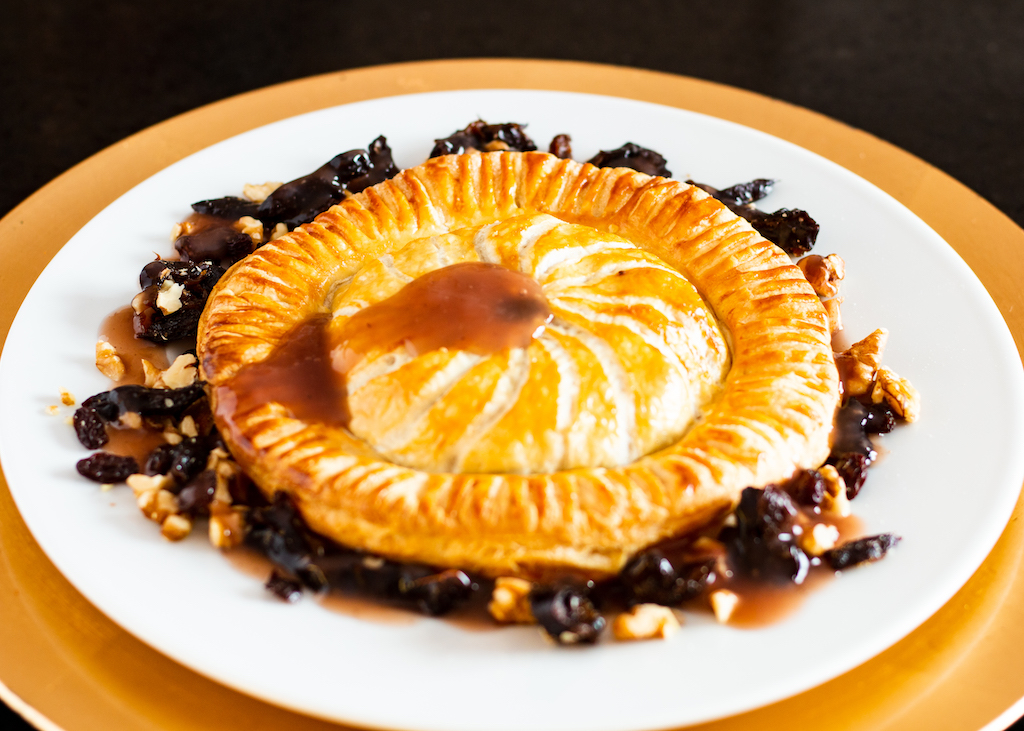


 (17 votes, average: 3.47 out of 5)
(17 votes, average: 3.47 out of 5)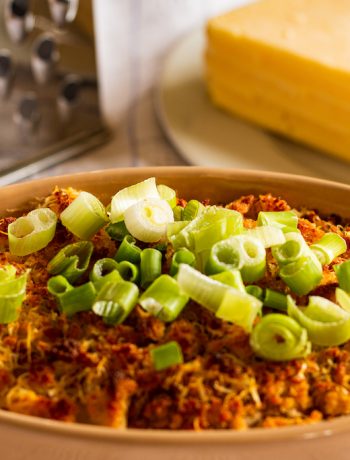
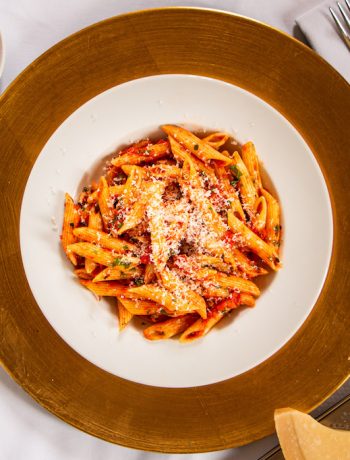
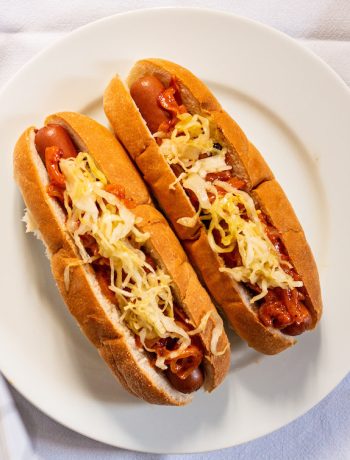
No Comments